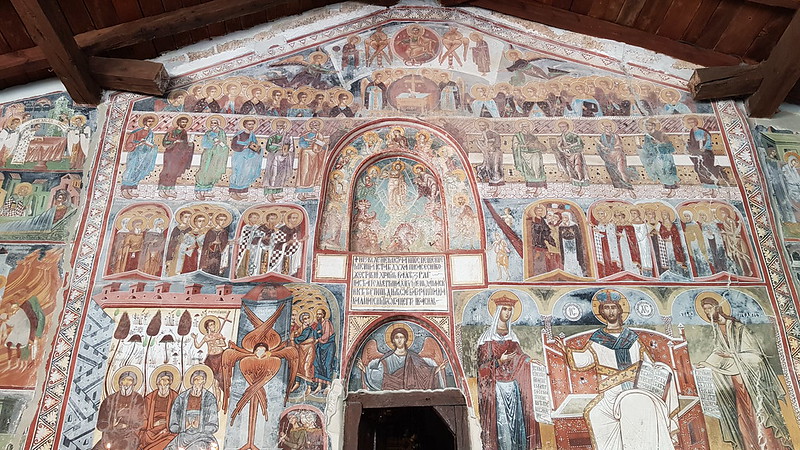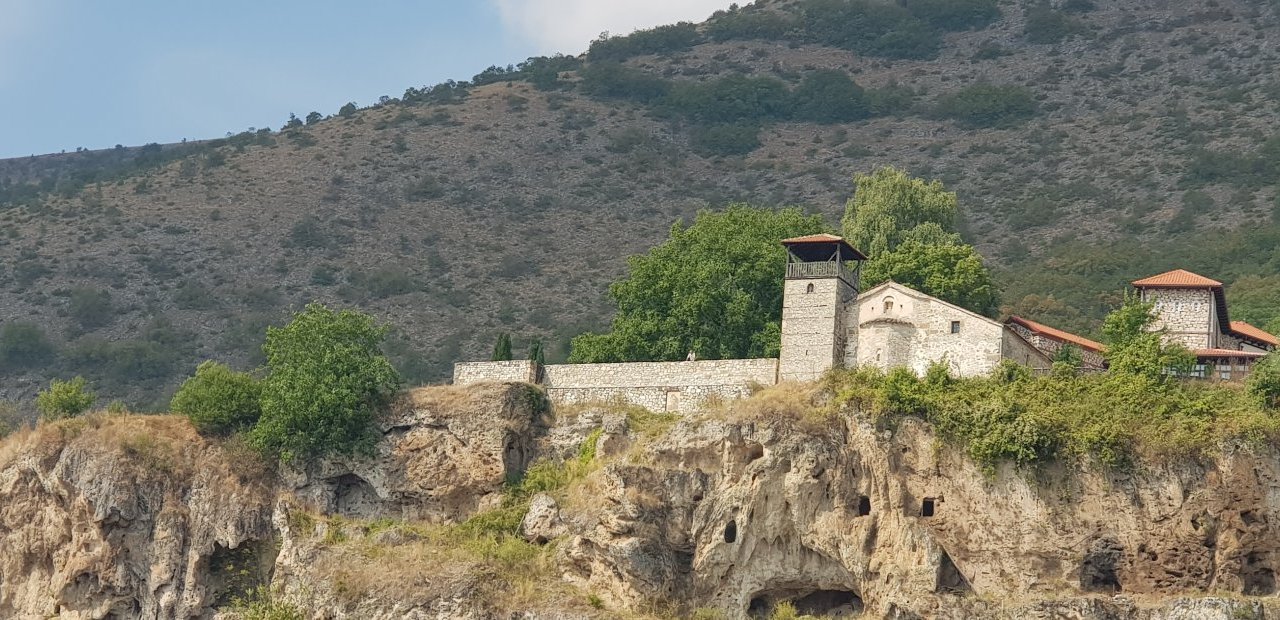There is a place in Macedonia that marries spirituality, history and natural beauty; and at the same time rays peacefully. That place is insufficiently discovered and non-commercial. That place is the Macedonian Meteora (rocks in the air), which seem to touch the sky with its peaks. Therefore, it is not surprising that in the past these were the chosen rocks by the monks for praying, being alone and quieting. That place is the Zrze Monastery complex, almost 1.000 meters above sea level, on the southern slope of the mountain Dautica.

Zrze Monastery (also known as Zrzenski Monastery, Zrzevski Monastery or "St. Spas") is located 34 km northwest of Prilep, near the village Zrze. The legend for the origin of the name of Zrze, comes from the murmuring (Macedonian: zrzorenje) of the river Bojanik, after which the village gets its name. To the monastery, that priceless pearl from the Macedonian cultural and historical sacristy, can be reached by asphalt road, which passes through the Prilep villages Ropotovo, Peshtalevo and Kostinci finishing in the village Slepche.
The road to the monastery is historical voyage and timeless at the same time. The untouched nature caresses all the senses and touches the deepest feelings. The intoxicating scents of sage and thyme, accompanied by the scent of several centuries-old walnut trees, the tweeting of birds and the murmuring of the river, provide beyond ordinary experience along the path, which is probably the same from the late ancient period of Saint Clement of Ohrid.

A bit history
The monastery complex in the past was on a much larger area than today (7.000 square meters). Although until recently it was believed that the monastery dates back to the 14th century, the results of archaeological research in 2008 have shown that the beginning of the Zrze's monasticism dates back to the 9th century. From that period is the monastic settlement of hermit cells, carved into the vertical hollows of the limestone, on the northern, eastern and southern borders of the monastery complex.
In the time of Saint Clement of Ohrid, the second half of the 9th century, the monks inhabited the Zrze's limestone, filling it with spirituality. They prepared it for their home, making it habitable in its natural forms and taking care not to break the relief. There are 7 levels with more than 30 building forms – basilicas, shrines, cells, workshops, holes... In the immediate vicinity of the monastery, basilica from the 5th century and tomb of a saint from the 4th century were found.

Above the ancient monastic settlement, in the middle of the 14th century, in the time of Tsar Dushan (1345-1355), the monk German established a society with church, dedicated to the Hesychasm's feast, the "Holy Transfiguration of Christ".
The word "hesychia" literally means "stillness", "rest", "quiet" and "silence", but in Orthodoxy it has a much deeper meaning. It signifies man's constant striving for serenity. Just as the "calm sea" is not beneath the surface of the sea but in its depths, so man's inner peace is deep in him. The Transfiguration of Christ or the Transfiguration of the Lord is a Christian feast, celebrated every year on the 19th of August or according to the Julian calendar on the 6th of August. According to tradition, in order not to weaken the faith of the apostles after Christ's suffering and death, Jesus wanted to show them at least some of his divine glory. So, He with Peter, James and John, went up into the mountain of Tabor at night and there He transformed, commanding them not to talk about what they had seen until his resurrection.

After German's death, his grandchildren, Metropolitan Jovan of Pelagonia and the hieromonk Makarij, took over the management of the monastery. They, both painters, are the creators of the most important pieces of the Zrze's Iconography School. Jovan is the creator of the icon "Christ the Savior and the Life giver" (1391), and Makarij of the miraculous icon "Holy Virgin Pelagonitissa" (1422). Both icons are made in Byzantine style and are extremely valuable.
By coming under Ottoman dominance, the brothers ceded the monastery to mayor Konstantin and his sons Jacob, Kaloyan, and Dimitar. After the death of the mayor and his sons, the monastery began to collapse, and at the beginning of the 16th century had great damage, even the vaults of the church were destroyed. The original church was rebuilt around 1535 and painted.
Over the centuries, the monastery has undergone numerous challenges – it has been burned, destroyed and rebuilt, looted and reestablished. Followed by years of poverty and prosperity, war and peace… the monastery has always survived with the carefulness of the invincible peasants and the monks.

Since 1998, with the establishment of the monastic community, the Zrze Monastery has been restored into a male monastery. At the beginning of the 21st century, for the third time in its history, Zrze became the episcopal residence, this time of Bishop Clement of Heraclea, secretary of the Holy Synod of Hierarchs of the Macedonian Orthodox Church – Ohrid Archbishopric (MOC-OA). The icon-painting workshop, in which monks make frescoes and icons in the traditional technique with gilding of 24-carat gold and natural colorс, continues the centuries-old ritual.
The last renovation of the monastery was completed in February 2015. Then the monastery hospice was renovated, as well as the refectory, the tower next to the entrance gate, the northeast wall and the upper gate.
A bit legend
The icons "Christ the Savior and the Life giver" and "Holy Virgin Pelagonitissa" are anthological and invaluable because of their artistic, national, historical and spiritual significance. The original of the most famous icon from Zrze, "Holy Virgin Pelagonitissa", today is kept in the Museum of Macedonia in Skopje, but there is a large copy in the monastery church.
Characteristic of these icons is that their position is the opposite of the position of the icons of Jesus and Holy Virgin in other Christian churches and monasteries. In this monastery church, the icon of the Mother of Jesus is on the right, and the icon of Jesus is on the left. Namely, the icons were placed three times in a row by the monks according to the canons of Orthodoxy, but overnight they changed their place. Three days and three nights later, when the abbot asked the icon why it was changing the place, the lips of the Mother moved, and she replied: I don't want to turn my back to my son – that's why I am changing the canonical place.

Among the many legends about Zrze is that the kings Volkashin and Marko were married in this monastery. This monastery once was surrounded by protective walls. Wall stones were used in the 1930s to build monastery hospices. According to some researchers, there is a "tower of King Volkashin" in the monastery of Zrze.
A bit serenity
Today, the monastery unit includes the churches "Holy Transfiguration", "St. Peter and Paul" and as its metochion (monastery property) is the church "St. Nikola" in the village of Zrze.
The "Holy Transfiguration" was built in the 14th century, and the frescoes inside date from the 16th and 19th centuries. It is a vaulted one-nave church with a semicircular vault and a semicircular inner apsis.

"St. Peter and Paul" was built in the 17th century and extended in the 19th century. Inside the church there is a fresco depicting a shepherd in folk costume. This temple is also known as the Shepherd's Church, in honor of the shepherd who died defending the monastery from the malefactors who wanted to destroy it.
The monastery bell is located in the middle part of the complex, near the church "St. Peter and Paul". It is attached to a white marble frame, which rises above one of the monastery walls.
The church "St. Nikola" in the village of Zrze is a metochion of the Zrze Monastery On the north side of the construction, a fresco-icon of the Virgin Hodegetria was discovered, created by the painter Dragoslav in 1368/1369. The church is located on the far northwestern part of the village, on the left side of the road that continues to the monastery.

Due to the location of the Zrze Monastery on a large limestone from which the whole valley can be seen, the monks usually notice the arrival of visitors. With great kindness and hospitality, they usually greet guests even before they arrive at the grand entrance gate of the complex. Depending on the visitor's wishes, the hosts can leave him alone to enjoy in the tranquility, or take him for a walk through the monastery, narrating the unusual legends and unraveling their meanings.
Under the slopes of Dautica, the monastic feat of the fraternity lasts and develops. Nowadays the fraternity diligently works on icon-painting and creating a legacy for future generations.

Finally, part of a wonderful quote from the saint Porphyrios (Bairaktaris) the Kapsokalyvite: Take advantage of the beautiful moments. They bring the soul to prayer; make it gentle, noble and poetic... When you are amazed by a beautiful landscape, a small church, something beautiful, do not just stick to it, but go further... Rejoice in everything. It makes us richer and leads us to the great Love, to Christ.
Source: Balkan Prime Tours
